#Rolin Museum
Text

Bellerophon, riding Pegasus, slays the Chimera. Gallo-Roman mosaic, artist unknown; 2nd or 3rd cent. CE. Found in Autun, France; now in the Rolin Museum, Autun.
#classics#tagamemnon#Ancient Rome#Roman Empire#classical mythology#Bellerophon#Pegasus#Pegasos#Chimera#Chimaera#art#art history#ancient art#Roman art#Ancient Roman art#Roman Imperial art#Gallo-Roman art#mosaic#ancient mosaic#Rolin Museum
679 notes
·
View notes
Text
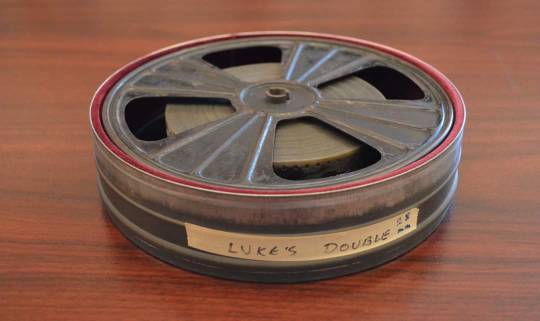

From the UCLA Film & Television Archive facebook page:
Terrific news for silent film fans! A long lost Harold Lloyd short, “Luke’s Double” (1916), has been recovered by the Harold Lloyd Estate and deposited at the UCLA Film & Television Archive for eventual preservation.
The short comedy, produced by Hal Roach’s Rolin Film Company for Pathé, features Harold as his earlier, more Chaplin-esque “Lonesome Luke” character before he became an icon worldwide as the bespectacled go-getter we remember today.
The 28mm print (a film format introduced by Pathé in 1912) was originally gifted to Harold Lloyd by the George Eastman Museum in the mid-1960s. The print disappeared in the subsequent decades, but Robert Simonton recently tracked down the film and Harold’s granddaughter, Suzanne Lloyd, brought it to the Archive to join the rest of the Harold Lloyd Collection. 🎞
#harold lloyd#lost films#founs films#silent film#silent cinema#classic hollywood#classic film#lonesome luke#luke's double#1910s#10s#1916
73 notes
·
View notes
Text
Paley Weekend 2022 - Interview with the Vampire screening!
As I think the only one on Tumblr at the screening, I’d like to give my thoughts!
First off, the Paley Weekend takes up an entire city block. It was a celebration of everything media related, with many sports and video game related sections on the street. Inside the actual museum are the four trophies of the four major sports (basketball, football, hockey, and baseball). Most people wanted to get their picture with those. As I got in line, a worker from Paley said the line was cut off. I showed them that I was only there for the screening and got in!
I had to get back out of line to get a ticket for the event. It’s a good think I took a picture of it because they collected it within ten minutes.

They gave a disclaimer that the episode would have sexual content and violence, and a mother with her children left. By the time the episode started I’m pretty sure there were only adults in the room.
The event started on time, with an ad for the Paley Museum, and then the cast (Louis, Lestat, Claudia, and Daniel or Jacob, Sam, Bailey, and Eric) came out with producer Marc Johnson. Rolin Jones was not present.

I made eye contact with Sam Reid for about 5 seconds and had to look away because he was very intense, in a good way. I def have good feelings about him being Lestat long-term.
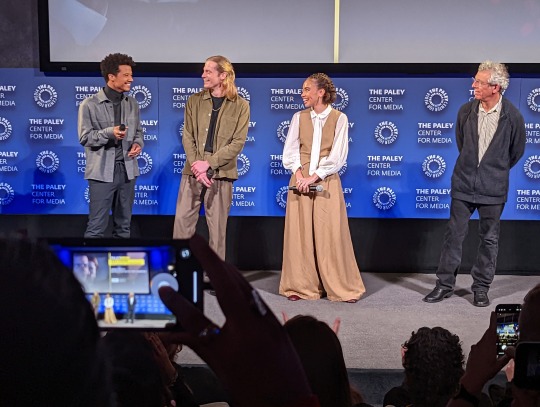
The cast was not on stage long, no more than two minutes, but they were all very excited about the show. None of them said anything new about the show. Jacob is happy to be there. Sam loved these books since he was 13. Bailey is excited to show how feral Claudia is. And Eric really enjoyed working with everyone on the show.
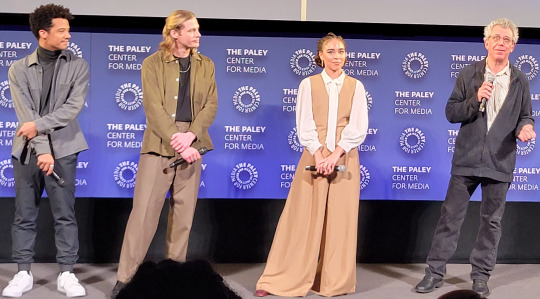
When the cast left they started a screening of the first episode. Since this was my third time seeing the episode since it dropped, I could tell it was the same version that is on AMC+. I don’t know what they are going to cut for TV.
I knew exactly what to expect with the show, but most of the audience didn’t. They laughed more than I expected. The laughed at the shitbox scene. They laughed when Paul said he ate too much cake. There was even laughter right up until Paul jumped. But the reaction after was intense. Gasping and shocked sounds all around. It was pretty quiet during the��‘sex’ scene, but I take the silence as enjoyment. During Louis’s church scene and turning I could see many members of the audience literally sitting on the edge of their seats. There was a solid round of applause when the episode finished, and I think out of the room of 200 or so viewers, almost all really liked it.
#Interview with the Vampire#amc interview with the vampire#amc iwtv#hulu iwtv#shout out to the lady behind me with vampire fangs on#i had my lestat tshirt on#but it was too rainy and cold to go without a jacket#feel free to send me asks for questions or more pictures!
36 notes
·
View notes
Text
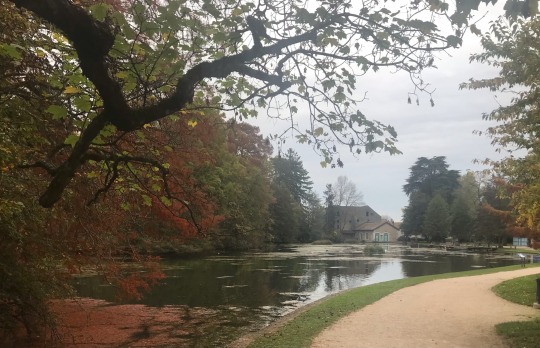







November 3 - spent two nights in Beaune, the heart of Burgundy. After a stroll through the park into some local vineyards we toured the Hotel Dieu des Hospices de Beaune. The medieval charity hospital is now a museum. The hundred years war and the plague (a.k.a. the black death) devastated Beaune leaving 3/4 of the population destitute. Nicholas Rolin, chancellor of Burgundy, (enriched in part by his power to collect taxes) was getting old and decided to close out his life on a philanthropic rather than a greedy note. So in 1443, Rolin paid to build the place. It served the area until 1971 when the foundation closed it after building a modern hospital. We also did a wine tasting where we learned much about the traditions and geography of the region. We now know enough to be dangerous ⚠️ Beautiful town!
0 notes
Text

Temptation of Eve, around 1130, made for the lintel of Autun cathedrale, Rolin Museum, France
1 note
·
View note
Photo
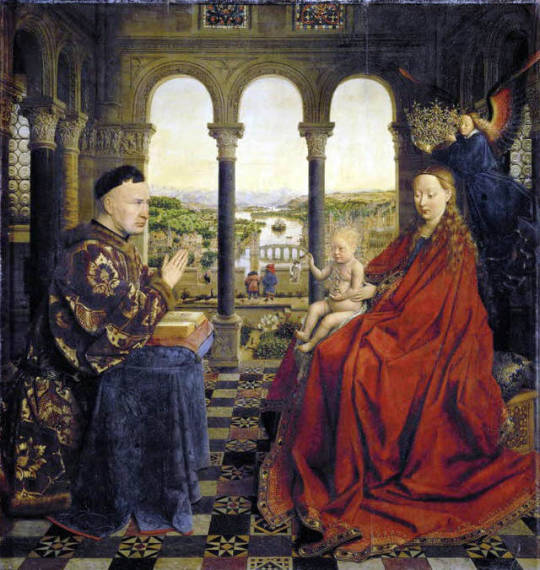
A discussion of Madonna of Chancellor Rolin by Van Eyck - TripImprover - Get More out of Your Museum Visits!
10 notes
·
View notes
Text

Bellerophon riding Pegasus and killing the Chimera, Roman mosaic, the Rolin Museum in Autun, France, 2nd-3rd C. CE.
"He [King Iobates of Lykia (Lycia)] ordered Bellerophon to slay the Khimaira (Chimera), assuming that he would instead be destroyed himself by the beast, since not even a quantity of men could subdue it with ease, let alone one. For it was a single being that had the force of three beasts, the front part of a lion, the tail of a drakon, and the third--middle--head was that of a goat, through which it breathed out fire. It despoiled the countryside and ravaged the herds. It was allegedly reared by Amisodaros (Amisodarus), as Homer also states, and according to Hesiod its parents were Typhon and Ekhidna (Echidna). Bellerophon mounted Pegasos (Pegasus), his winged horse born of Medousa (Medusa) and Poseidon, and flying high into the air brought down the Khimaira with his bow and arrows."
-Pseudo-Apollodorus, Bibliotheca 2. 31 - 32 (trans. Aldrich) (Greek mythographer 2nd C. CE)
...
"This large medallion is the central part (emblema) of a 110m2 mosaic. This sumptuous floor decoration certainly took place in the reception hall of an aristocratic residence. Discovered in Autun in 1830, it was first presented there, then bought by the State for the Louvre, then the Museums of National Antiquities, before returning to the Rolin Museum in 1985. The medallion treats on a black background the subject of Bellerophon riding Pegasus and slaying the chimera, a monster with the body of a lion, a goat and a serpent. Here the hero is about to ram his spear into the animal's throat. This theme evokes the victory of intelligence and bravery over evil, and Bellerophon is a model of an ancient hero. The same posture will be taken up in Christian times in the iconography of Saint George."
-taken from wikipedia
#bellerophon#classical art#ancient rome#archaeology#greek#art history#european art#pagan#paganism#antiquities#literature#pegasus#chimera#museums#mosaic#europe
252 notes
·
View notes
Text
Almost normal, but still weird: Jennifer Kelly’s year of venturing back out
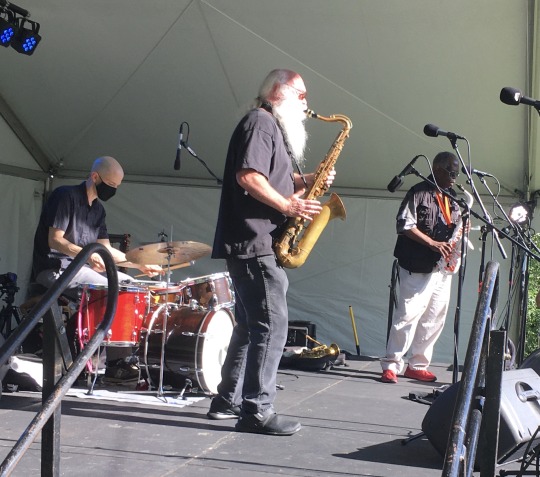
Chris Corsano, Paul Flaherty and Joe McPhee at Long Live the Thing!
Ah, remember the hopeful days of May and June, when newly vaccinated stirred from their burrows and nosed cautiously out into the warm spring air. Beers could be quaffed at outdoor tables. Trips to elderly relatives could be considered. And concerts could be attended, if a little nervously.
I went to see E, the post-punk band that Thalia Zedek shares with guitar-tinkerer Jason Sanford, in June. It was a triumph. They were great (and also on their first live outing in several years). But it was also very strange. I had become nervous around people in ways that owed nothing to the pandemic. Also, in a pattern that would repeat, I was absolutely sure I had COVID the day after. (I did not.)
I saw Chris Brokaw reprise his barn-burning rock record Puritan a few weeks later, fronting the power trio that plays on the album but which normally travels no further than New England. It was fantastic. I was thrilled. And again, I was a little frightened. A weird rash developed, which I thought must be COVID rash. (It was not.)

Chris Brokaw Band at Arts Nova, Keene NH
The summer went on this way. I’d dash out to shows in excitement and follow up with days of dread. We spent a whole day outside in Peterborough at a September edition of the year-delayed Thing in the Spring (called Long Live the Thing! this time because it was not, duh, the spring anymore.) Joe McPhee blew me away. Sarah Louise charmed and enchanted. Bonnie Prince Billy and Matt Sweeney put on a surreal and beautiful set as Superwolves to close things out, and it was a festival, like a dozen other festivals from years past, though made strange by absence. I made another foray out to see Tobin Sprout and once, to meet up with Dusted friend Michael Rosenstein for dinner and then catch Bill Nace and the Powers/Rolin duo in Greenfield, MA.

Tobin Sprout at Arts Nova, Keene NH
And so, it was a year of returning to live venues, to eating out, to traveling in early November to Chicago again to see my son for the first time in two years. All good stuff. All welcome and celebrated. But none of it as casual, as taken for granted, as devoid of dread as it had been before. Welcome to the new normal. Just like the old normal except it scares you to death (and might kill you, though probably not, you big wuss!).
It was also a pretty good year for music though, and here’s the secret: it always is. You just have to listen to enough records to make it so.
Here are ten that I loved, described in some depth and another 40 to 50 listed. You could make a big deal out of the numbers or the placements but don’t. They’re all extremely good records.
Indeed, the list has been in a bit of flux since I first made it in October. I had flat out forgotten about Superwolves the first time around, for one thing. For another, I reviewed a string of really excellent albums from October on. NOUS/Laraaji, Michael Hurley, Endless Boogie, Bitchin Bajas, Emily Robb and Rider/Horse all came late in the year and all seemed worthy of at least a slot on the big list. It became a very big list indeed.
I’ve linked reviews and/or interviews where possible if you want to read more.
1. Cassandra Jenkins—An Overview on Phenomenal Nature (Badabing)
Cassandra Jenkins nailed the zeitgeist this year with her emotionally vulnerable, cerebrally challenging, gob-smackingly gorgeous album of not quite just singer songwriter songs celebrating life in the midst of sorrow. Everybody else is pointing to “Hard Drive,” as the hit here, and it’s very good, with its brainy museum guard sample, its sharp, driving rhythms, its blowsy dream-like sax around clear-eyed lyrics, but I like “New Bikini” best. “Let’s get you in the water/the water, cures everything,” Jenkins breathes, and amen to that.
2. Reds, Pinks and Purples—Uncommon Weather (Slumberland)
Like all the best pop songs, these lo-fi janglers smile and sigh at the same time, finding beauty in the fuzz and ambiguity of music—and human life itself. Glenn Donaldson imbues these tracks with a casual grace that recalls the best of 1980s New Zealand, but there’s a sardonic humor in the cuts about the music world. Stay right to the end for “Sing Red Roses for Me,” a song that hasn’t gotten much focus but whose chorus destroys me every time.
3. Chris Brokaw—Puritan (12XU)
Brokaw’s first unambiguously rock album in years, Puritan builds monumental sonics out of power trio basics. The title track makes you remember that Brokaw was in Come; its onslaught of guitar sound flickers and shifts in oblique post-rocking ways. “Bragging Rights” brings in Come bandmate Thalia Zedek for a mournful, acoustic interval. But it’s “Heart of Human Trafficking” that raises the stakes, with a rumble and roar that sounds great on record and even better live. Brokaw has never made a bad record, and this is a great one.
4. Mdou Moctar—Afrique Victime (Matador)
youtube
Mdou Moctar’s 2019 album Ilana: The Creator made the case that the world’s current guitar shredding champion lived in sub-Saharan Africa, but Afrique Victime dials down the pyrotechnics to settle into hypnotic communal grooves. Not ready to give up on the double-tapping prowess? Check out opening “Chismiten” or the soul-stirring title track, both enlivened by astonishing displays of virtuosity.
5. Myriam Gendron—Ma Delire: Songs of Love Lost (Feeding Tube)
Myriam Gendron has only made one other album, a haunting re-imagination of the poems of Dorothy Parker, so I wasn’t quite prepared for how unearthly beautiful this one was. The Montrealean revisits Canadian folk songs, exploring their many lives as pre-industrial people’s music, as fodder for the 1960s folk revival and as post-modern meditations on love and sorrow. Essential, spare and adventurous, Gendron’s dream is flat-out gorgeous.
6. Sleaford Mods—Spare Ribs (Rough Trade)
Sleaford Mods’ Jason Williamson has run into a bit of flack lately for his support of Spotify, but that’s just him, with his outrageous opinions on everything. The surprising thing is how progressive he is, making a conscious effort to bring women’s voices into his laddish provocations. On Spare Ribs, like-minded punkers including Billy Nomates and Amy Taylor from Amyl and the Sniffers, spit corrosive verses to Andrew Fearn’s abstract and stuttering rhythms, while the Marxist academic Dr. Lisa McKenzie observes the historic plight of women in “Top Room.” Full of spit and bile and contrariness as always, but more inclusive.
7. Guardian Singles—S-T (Trouble In Mind)
The always great Chicago indie label Trouble In Mind had an even better than usual year in 2021, with excellent albums from Dummy, Smoke Bellow, FACs, Mountain Movers and Nightshift, but my favorite was Guardian Singles, a rambunctious Aussie punk record that recalled the best of the melodic post-punk bands—Mission of Burma, Wire, Feelies and the Clean—with a brash, fresh, idiosyncratic energy. “I’m so tired of never being alone,” rattled around my head like an antic mantra, while the fizz and pop cacophony of “Heartland” set my pulse racing.
8. Arab Strap—As Days Get Dark (Rock Action)
“I don't give a fuck about the past/Our glory days gone by/All I care about right now/Is that wee mole inside your thigh,” mutters Aidan Moffat in his scratchy Scots brogue at the outset of As Days Get Dark, but Arab Strap’s morose, sardonic, filthiness has aged surprisingly well. Still obsessed with sex, the band finds a kind of tenderness in a song about jacking off to old photos of the wife, and a strangled poetry in the way we cope with aging and loss. The writing is spot on, too, best line: “I come on strong with a limerick. She knocks me back with a villanelle.”
9. The Bevis Frond—Little Eden (Fire)
As he approaches 70, the Bevis Frond’s Nick Salomon can still rip a searing Hendrix-style guitar solo and can still construct serpentine pop melodies stick in your head. This sprawling double album was recorded entirely by Salomon, except for one track’s worth of drumming, and there’s not a slack moment in it, though you’ll swallow hard when “As I Lay Down to Die” forces you to contemplate a world without the Bevis Frond.
10. Six Organs of Admittance—The Veiled Sea (Three Lobed)
Ben Chasny makes a lot of different kinds of music—the hushed acoustic reveries from records like School of the Flower, the blistering feedback laced scrawls of the first Hexadic album, the free-ranging improv of his work with Rangda—but he seldom puts it all on one album as he did with this astonishing record on the Three Lobed label. “Somewhere in the Hexagon of Saturn” flits airily on flickering electronics, its guitar solo a rough monolith in a garden of butterflies. “Old Dawn” meditates on long washes of tone, and the semi-title track “Last Station, Veiled Sea” brings the slow-building revelations of Six Organ’s latter work on Companion Rises. But it’s the weird stuff that keeps me engaged—the boisterous electro-pop of “J’ai Mal Aux Dents” and the stinging no-wave disco of “All that They Left You.” Who knew he could do this? Who knew it would be my favorite part?
Let’s not even call them honorable mention. Here are a bunch of other records that I loved.
Pelt—Resistance Reticence (Three Lobed)
Damon & Naomi with Kurihara—A Sky Record (20/20/20)
Doran—S-T (Spinster)
Bonnie Prince Billy and Matt Sweeney—Superwolves (Drag City)
The Chills—Scatterbrain (Fire)
Mess Esque—S-T (Drag City)
Dummy—Mandatory Enjoyment (Trouble in Mind)
The Goon Sax—Mirror II (Matador)
Rosali—No Medium (Spinster)
GG King—Remain Intact (Total Punk)
The Mountain Goats—Dark in Here (Merge)
Jupiter & Okwess—Na Kazonga (Strut)
Emily Robb—How to Moonwalk (Petty Bunco)
New Bums—The Last Time I Saw Grace (Drag City)
Rose City Band—Earth Trip (Thrill Jockey)
Michael Hurley—The Time of the Foxgloves (No Quarter)
Lorkin O’Reilly—Marriage Material (Team Love)
NOUS, Laraaji and Arji OceAnanda — Circle of Celebration (Our Silent Canvas)
Ovlov—BUDS (Exploding in Sound)
Bill MacKay & Nathan Bowles—Keys (Drag City)
Bitchin Bajas—Switched on Ra! (Drag City)
Rider/Horse—Select Trials (Ever/Never)
The Colorist Orchestra with Howe Gelb—Not on the Map (Dangerbird)
Fiver with the Atlantic School of Spontaneous Composition—S-T (You’ve Changed)
Reigning Sound—A Little More Time with the Reigning Sound (Merge)
Endless Boogie—Admonitions (No Quarter)
Strapping Fieldhands—Across the Susquehanna (Petty Bunco)
Yasmin Williams—Urban Driftwood (Spinster)
#dusted magazine#jennifer kelly#yearend 2021#cassandra jenkins#chris brokaw#reds pinks and purples#mdou moctar#myriam gendron#the sleaford mods#guardian singles#arab strap#bevis frond#six organs of admittance
9 notes
·
View notes
Text
Musée de l'Hôtel-Dieu - Hospices de Beaune, France


The Hospices de Beaune or Hôtel-Dieu de Beaune is a former charitable almshouse in Beaune, France. It was founded in 1443 by Nicolas Rolin, chancellor of Burgundy, as a hospital for the poor. The original hospital building, the Hôtel-Dieu, one of the finest examples of fifteenth-century Burgundian architecture, is now a museum. Services for patients are now provided in modern hospital buildings.
Some of the rooms are currently used for the COVID 19 vaccination: The Hospices perpetuate the tradition.
#May I just say this is the most beautiful building I've seen in my life#And it's inspired by flandres architecture so it basically feels a bit like home... With a southern touch and a beautiful colour palette#France#french architecture#Beaune#tour de france
8 notes
·
View notes
Text
Hospices de Beaune - Οne of the oldest original hospitals in the world in Beaune
Hospices de Beaune – Οne of the oldest original hospitals in the world in Beaune
It was founded in 1443 by Nicolas Rolin, chancellor of Burgundy, as a hospital for the poor. The original hospital building, the Hôtel-Dieu, is now a museum. The Hospices de Beaune inspired by the most outstanding hôtels-Dieu of Flanders and Paris and is one of the best preserved renaissance buildings in Europe. An important charity wine auction is held in November each year.
Hospices de Beaune…
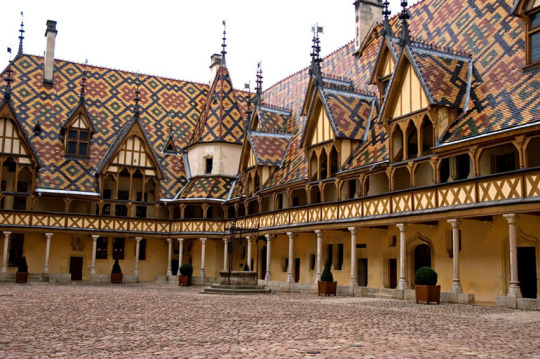
View On WordPress
0 notes
Text
Damaris Hurtado Pérez: Van Eyck: revolución óptica
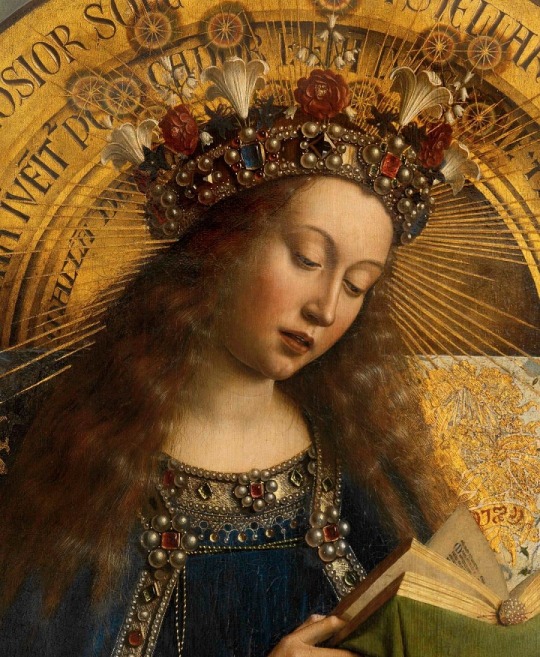
Quince días después de su nacimiento, el 7 de marzo de 1500, el emperador Carlos V fue bautizado en la catedral de San Bavón, en Gante. La verticalidad de la nave central, con sus ligerísimos arcos de ojiva disparados al cielo, se vistió de tapices flamencos con hilos de oro y plata; las vidrieras góticas, con su séquito celestial, cumplían la función simbólica de transformar la iluminación interior en una luz distinta a la del mundo. Se construyó una pasarela con cuarenta arcos representando cada uno los futuros estados del recién nacido y una de las madrinas, Margarita de York, portó al bebé sentada en un trono precedido por una fastuosa comitiva real.
Autor Colaborador: Marina Valcárcel
Licenciada en historia del Arte


Quince días después de su nacimiento, el 7 de marzo de 1500, el emperador Carlos V fue bautizado en la catedral de San Bavón, en Gante. La verticalidad de la nave central, con sus ligerísimos arcos de ojiva disparados al cielo, se vistió de tapices flamencos con hilos de oro y plata; las vidrieras góticas, con su séquito celestial, cumplían la función simbólica de transformar la iluminación interior en una luz distinta a la del mundo. Se construyó una pasarela con cuarenta arcos representando cada uno los futuros estados del recién nacido y una de las madrinas, Margarita de York, portó al bebé sentada en un trono precedido por una fastuosa comitiva real. Este bautismo funcionó a la manera de una coronación, dejando atrás los sencillos bautizos medievales e instaurando el ritual borgoñón en la corona española. Pero la pompa y la solemnidad no lograron impedir que, al entrar en la catedral, las miradas se volvieran hacia la capilla Vijd. Allí, el 6 de mayo de 1432, había sido inaugurado La Adoración del Cordero Místico, el Políptico de Gante, pintado por Hubert y Jan van Eyck, que ofrecía a un público maravillado una nueva y sorprendente forma de ver el arte.

Cortejo ceremonial grabado alemán siglo XVI.
En 2012 un equipo del Instituto Real Belga para Patrimonio Artístico empezó las labores de restauración del Políptico en un laboratorio del museo de Bellas Artes de Gante (MKS). En la primera fase, al levantar las distintas capas de barniz, se descubrieron amplias zonas de repintes que -probablemente desde el siglo XVI- mantenían la obra eyckiana oculta. Por primera vez era posible ver los paneles exteriores del Políptico en su estado original: colores de cielos y ciudades, pliegues y alfileres ocultos en los tocados, luz bañando la piel de sus personajes y la ilusión del tacto del mármol simulado en las estatuas de los dos san Juanes. Hallazgos que permiten intuir y coser muchos de los misterios de la pintura de Jan Van Eyck (Maaseik? h. 1390 - Brujas, 1441). Ese fue el germen de esta exposición irrepetible que presenta las ocho tablas antes de que vuelvan, ya para siempre, a la catedral de San Bavón. Ellas vertebran las trece misteriosas y oscuras salas, con sus paredes pintadas alternativamente en el rojo y el azul ultramar de los mantos de las vírgenes y su iluminación que parece salir desde dentro de los cuadros: casi 100 obras de esta muestra repartidas entre Masaccio, Pisanello o Fra Angelico, sus contemporáneos italianos, algunos de sus contemporáneos flamencos y, sobre todo,13 de los 20 cuadros que se conocen en el mundo de Jan van Eyck. Recopilación nunca antes vista.

Laboratorio del museo de Bellas Artes de Gante (MKS). Restauración del Políptico.
El viajero que se aproxime a Brujas y vea surgir delante de los canales los pequeños jardines cerrados con sus frutales en espaldera y las altas flechas de los campanarios estará viendo las mismas calles y sus casas, las mismas iglesias al borde de un puente que Van Eyck. Poco parece haber cambiado desde 1430. De la misma manera, cuando nos encontramos frente a un cuadro flamenco del siglo XV, creemos penetrar la intimidad de la vida de otro tiempo.

La Adoración del Cordero Místico (detalle), Políptico de Gante, 1432, Catedral de San Bavón, Gante.
Sedas y mecenas
El nacimiento de la pintura flamenca estuvo determinado por la derrota francesa en Azincourt que, en 1415, marca durante décadas el colapso de Francia. Apartada de la interminable guerra franco-inglesa, Flandes se consagra a su vocación de comercio. El asesinato en 1419 del Duque de Borgoña, Juan sin Miedo, empuja a su hijo, Felipe el Bueno, a separarse de los Valois y a trasladar la capital de Dijon a Brujas, esa ciudad protegida y libre a la que afluían mercancías venidas del Mediterráneo, del Báltico y todo el lujo de las naves de Oriente: especias y perlas, alfombras turcas, sedas brocadas de Siria... objetos que inundarán los espacios entre las Vírgenes, los altares y los donantes de Van Eyck. Brujas era, ya entonces, el centro de una escuela próspera de iluminadores. Entre ellos y bajo la influencia del mayor escultor de la época, Claus Sluter, Van Eyck empieza a pintar pliegues de mantos con el volumen de la escultura de los pórticos, caras de santos crujidas por gestos de dolor y a dejar que su pintura fuera naciendo desde el preciosismo y los colores del esmalte de los libros de Horas. La corte del duque de Borgoña era un paraíso para fortunas como las del banquero italiano Tommaso Portinari o la del canciller Nicolás Rolin, que favorecieron las artes y engendraron el mecenazgo. En este ambiente, en mayo de 1425, Jan van Eyck es nombrado pintor de corte de Felipe el Bueno, para el que emprende varios viajes lejanos y secretos de los que tan solo se conoce un destino: la Península Ibérica.
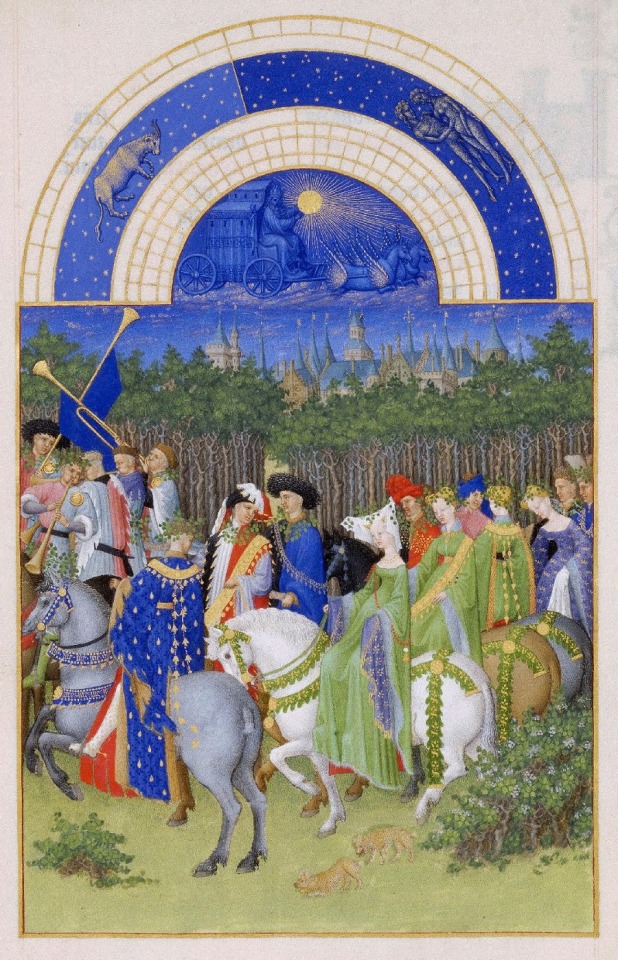
Los hermanos Limbourg, El mes de mayo. Página del Calendario en Las muy ricas horas del Duque de Berry, 1411-1416. museo Condé, Chantilly, Francia.
Esclavizar la luz
¿Quién era Jan van Eyck? ¿A qué responde su revolución óptica? ¿Qué es lo que le empujó a pintar así?
Podría decirse que el pintor esclavizó la luz, la sometió hasta conseguir que iluminara cada rincón de sus cuadros. Para ello fue sirviéndose de herramientas conocidas desde la Antigüedad que iba domesticando. Los últimos análisis científicos, tras la restauración del Políptico, demuestran que aprovechó la técnica del óleo y la llevó hasta sus límites reproduciendo todas las texturas posibles: de la seda al pelo, de las vidrieras a los suelos de azulejos valencianos, las coronas, la luz de la piel de un niño y el tono mate de la mano de un anciano, los libros, las encuadernaciones con sus letras de oro, los cielos y el brillo pálido de la luz menguante. Y así representaba la brisa de un bosque, los rayos entre las ventanas góticas de una iglesia, y todo el reflejo de una ciudad en un trozo de lago al fondo de un San Francisco cuyos estigmas tenían el brillo preciso en cada coágulo de sangre.
Todo cuanto veía en la naturaleza era trasladado por su pincel: distintos tipos de rocas, variedades de nubes, incluso se han podido realizar diagnósticos de enfermedades de la piel y nadie, salvo Leonardo, consiguió pintar con tal precisión el ojo humano, sus párpados, sus venas y el fondo de una mirada fija.

Jan Van Eyck, San Francisco recibiendo los estigmas, c.1440, Philadelphia Museum of Art.
Erwin Panofsky demostró que Van Eyck no tenía interés en aplicar las leyes matemáticas de la perspectiva como lo hacían sus contemporáneos florentinos. En la Anunciación del Políptico de Gante la tarima del suelo y las vigas del techo no solo no convergen, sino que ni se aproximan a ello. En la Anunciación de Washington, lejos de existir un único punto de fuga en el interior de la iglesia, hay varios. Van Eyck encontró una solución empírica para la representación de un espacio convincente basándose en la observación directa. Con ella llegó a crear perspectivas desdobladas, a sugerir ambas distancias: de las panorámicas con horizontes tan reales como inverosímiles a los detalles más minuciosos; aquello que Panofsky definió como la yuxtaposición de su mirada microscópica y telescópica. Y así, en un primer plano están los interiores en los que sus personajes habitan, esa intimidad que hoy nos fascina porque reconocemos en ella nuestro mundo, el mundo moderno del individuo concreto y sus cosas: sus guantes y sus alfombras, sus instrumentos musicales, sus azucenas y sus atriles. Resulta sobrecogedor ese afán por describirlo todo, incluso lo que no es necesario mostrar. Es esa misma intimidad doméstica y moderna que luego pintarán desde Vermeer y De Hooch hasta Chardin. A su vez, y por detrás o algo más arriba, se desarrolla otra escena tras una ventana o un balcón: la vista de una ciudad flamenca, sus torres, campanarios y calles que se pierden en un horizonte de lagos, montañas azules y cielos tranquilos. Paisajes infinitos y milimétricos que, a su vez, siglos más tarde, en 1806, pintará un joven Ingres en su Retrato de Mademoiselle Caroline Rivière.

Jan van Eyck , Anunciación, detalle.
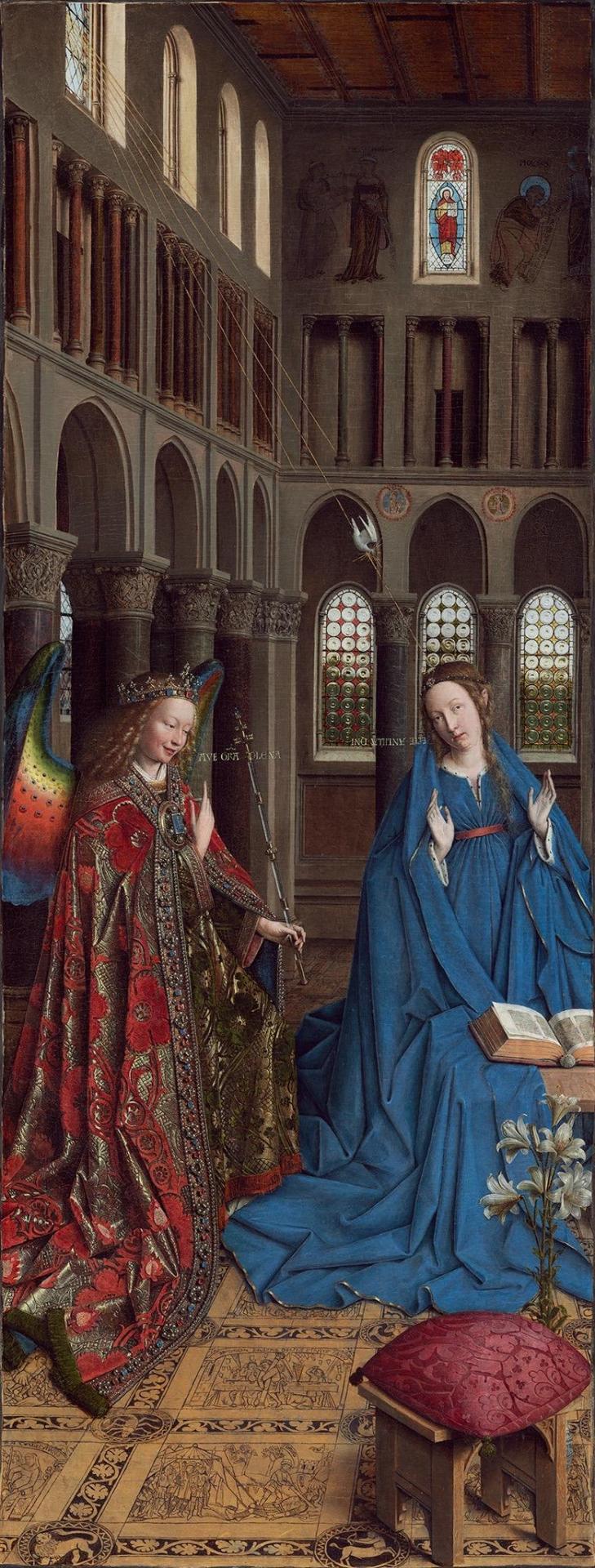
Jan van Eyck, Anunciación, c.1430-35. National Gallery of Art, Washington.

Jean-Auguste-Dominique Ingres, Mademoiselle Rivière, c.1793-1807. Musée Du Louvre, Paris.
Van Eyck padecía de una obsesiva fijación por la manera en que la luz cubre y forma las imágenes a partir de la reflexión y la refracción. El espejo debió de haber impregnado su mundo no solo como un objeto, también como una metáfora. Parte de su conocimiento venía de la observación, pero además, en su época se le consideró el primer pictor doctus (pintor ilustrado) al norte de los Alpes. Estaba familiarizado con los autores clásicos, había leído a Plinio el Viejo, era experto en geometría, en arqueología, pero sobre todo, conocía la óptica, aquella ciencia tardomedieval basada en los descubrimientos de matemáticos árabes, como Alhacén. Van Eyck la usó y perfeccionó hasta desarrollar una revolución óptica que aún hoy nos conmociona. La iluminación del Políptico de Gante se corresponde con la incidencia natural de la luz a través de las ventanas del sur de la capilla Vijd. En todo el retablo la luz cae desde la esquina superior derecha, como la luz del sol en la capilla en una tarde soleada a fines de la primavera o principios del verano. El grado de coherencia en la iluminación de todo el retablo es excepcional. En la figura del Dios Padre central, las joyas de su mitra, el punto focal del cristal de roca del cetro y todos los puntos de luz en la tela de brocado dorado alcanzan un grado de exactitud fotográfica.
Marc De Mey, que exploró la influencia de Alhacén en Van Eyck, fue el primero en señalar el tour de force del pintor al concebir las hileras alternas de perlas y cuentas de cristal que cuelgan de la tira brocada en oro con las letras Sabaoth en la figura del Dios Padre: mientras las primeras absorben la luz de la ventana, las de vidrio la proyectan, devolviendo amplios reflejos.
Hay centenares de ejemplos, desde el reflejo metálico de los estandartes rojos sobre las pecheras de las armaduras de San Miguel y San Jorge, hasta el reflejo de toda una ventana en el gran zafiro central del broche del ángel mayor en la escena de los Ángeles Cantores. La tracería de esa ventana fue arañada con la punta de su pincel, saturado con pintura blanca, usando la técnica del sgraffito.

Ángeles cantores (detalle), Políptico de Gante, 1432, catedral de San Bavón, Gante.
Resulta mágica también la maestría que el pintor flamenco presta al agua que fluye y salpica en la fuente del Políptico, así como en La Virgen de la Fuente. La iluminación juega un papel central en su realismo, pero también lo hace el movimiento: el salto de cada gota. El agua que sale de las bocas de ambas fuentes está pintada en líneas finas, blancas, irregulares e intermitentes. Es como si Van Eyck hubiese pasado una tarde junto a Bill Viola viendo sus vídeos de agua detenida.

Jan van Eyck, Virgen de la Fuente, (detalle), 1439, Koninklijk Museum voor Schone Kunsten, Amberes.
Flandes frente a Italia, 1430
La exposición enfrenta cuadros flamencos a sus contemporáneos italianos en un diálogo que reafirma nuestra pregunta: ¿Qué es lo que hace que Van Eyck aparezca como un cometa sobrevolando los años 1430 en el firmamento artístico europeo? Jacques Lassaigne y Giulio Carlo Argan afirmaron que el Renacimiento no es un movimiento típicamente italiano que se extiende a otros países como una suerte de conquista progresiva, sino y más bien, un fenómeno europeo a pesar de que se produce de manera diferente en Flandes, Italia, Francia o Alemania.
A principios del siglo XV asistimos a una de las mayores revoluciones que se hayan conocido en la historia de la pintura. Mientras Van Eyck pinta el Políptico en Gante, entre 1426 y 1432, Masaccio pinta en Florencia, entre 1426 y 1427, la capilla Brancacci, en la iglesia del Carmine. Italia funda la forma sobre el concepto, Flandes sobre la experiencia. Estas dos obras mayores nacidas, casi simultáneamente, de hombres tan distintos en origen y tradición son los pilares de una pintura nueva.
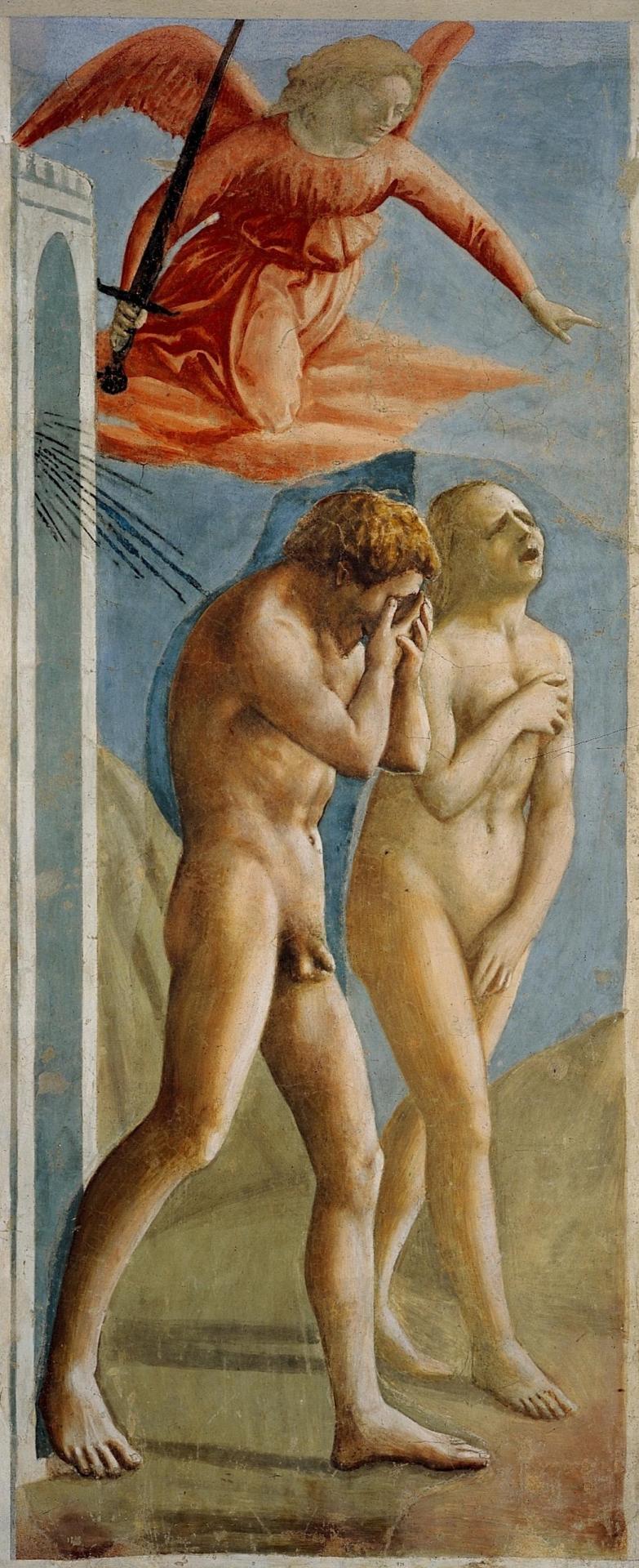
Masaccio, La expulsión del paraíso, c. 1426-1427. Capella Brancacci, Santa Maria del Carmine, Florencia.
Masaccio siguió pintando al fresco y los muros de la capilla Brancacci con su Adán y Eva de paso firme y gesto de angustia en la Expulsión del Paraíso, no pueden acompañar hoy a sus tocayos de Gante, más serenos, más inquietantes. Sin embargo, sí están otros revolucionarios de la óptica italiana: Gentile da Fabiano, Fra Angelico, Filippo Lippi... frente a los flamencos. Las comparaciones estilísticas son inevitables, interesantes: en Virgen y el Niño con Ángeles de Benozzo Gozzoli (1449-50) frente a la Virgen de la Fuente de Van Eyck (1439) los resultados del mismo pigmento ultramarino para el color de los mantos de las Vírgenes es muy distinto: tempera, más opaca en el italiano y veladuras cristalinas, mucho más intensas en Van Eyck. También el gusto duradero de los italianos por el pan de oro frente al enfoque naturalista de la pintura eyckiana, que sustituye los anticuados fondos dorados en favor de paisajes, los halos, que dejan de ser grandes discos que rodean las cabezas, en favor de rayos dorados más ligeros o los objetos dorados, que no se representan ya con oro real, sino con una pintura amarilla y marrón para simular la luz, la forma y la textura.
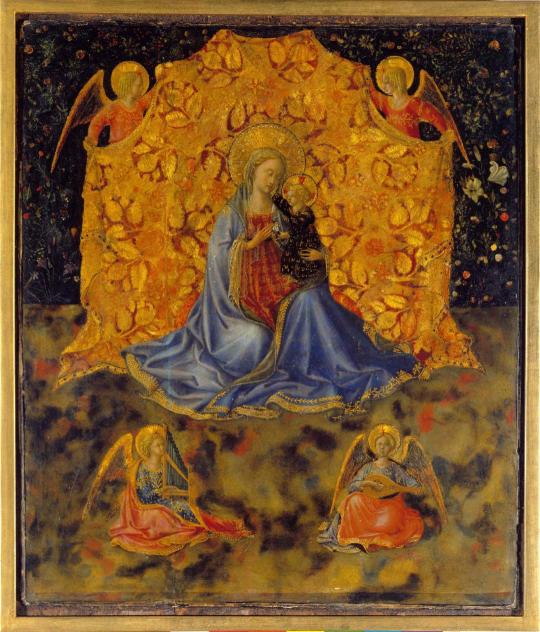
Benozzo Gozzoli, Virgen y Niño con ángeles, c.1449-1450, Fondazione Accademia Carrara, Bergamo.

Adoración del Cordero Místico, Políptico de Gante (detalle)
Ausencias
La penúltima sala de la exposición, dedicada al retrato, es quizás la más apabullante. Tzvetan Todorov decía que cuando se recorren la salas de un gran museo europeo salta a la vista un cambio radical en la naturaleza misma de los cuadros al pasar, digamos, de 1350 a 1450. Explicaba que en el norte de Europa no se produce ningún Renacimiento en el sentido de redescubrimiento de la civilización griega y romana como medio para hacer algo nuevo. A lo que se asiste, más bien, es a la búsqueda de una forma nueva para dar cuenta de experiencias igualmente nuevas. El denominador común de estos cambios no es el redescubrimiento de la Antigüedad, sino el descubrimiento de la individualidad. Por eso, en esta época se inventa el retrato individual, tal y como no ha dejado de practicarse después. Los hombres han tomado el lugar de Dios en el sistema del simbolismo universal.

Jan van Eyck, Baudouin de Lannoy, c.1435. Gemäldegalerie, Staatliche Museen, Berlin.
Y así, tras las Crucifixiones y Anunciaciones, esta exposición se cierra con los héroes de los tiempos nuevos. Son seis los retratos de Jan van Eyck, frente a sus contemporáneos italianos: Pisanello, Michele Giambono...
Entonces, en mitad de esta sala, nos surge la única duda en torno a esta muestra extraordinaria: ¿Dónde está Antonello da Messina con sus finísimos óleos sobre tabla? Más aún... ¿Dónde están los grandes cuatrocentistas venecianos: Vittore Carpaccio, Gentile y Giovanni Bellini?
Entornamos los ojos e inventamos una sola sala imaginaria, oscura, de fondo azul, vacía. Sólo están: Hombre con tocado rojo (1433) de Jan Van Eyck frente a Retrato de un hombre con gorro rojo (1485) de Vittore Carpaccio. Eso sí sería una lucha de gigantes: qué dos miradas, frente a frente.
Jan van Eyck lo dejó escrito en su divisa: Als ich can, lo hice lo mejor que pude.

Izda: Jan van Eyck, Retrato de hombre con tocado rojo, 1433. National Gallery Londres. Drcha: Vittore Carpaccio, Hombre con gorro rojo, 1485, Museo Correr, Venecia.
Van Eyck. Una revolución óptica
Museo de Bellas Artes de Gante Comisarios: Till-Holger Borchert, Maximiliaan Martens y Jan Dumolyn
Hasta el 30 de abril 2020
Ver Fuente
Ver Fuente
0 notes
Photo

Aladdin, Bad, and Friends: 20 FORGETTABLE ROBIN WILLIAMS MOVIE QUOTES presented QUOTE GOOD MORNING, VIETNAM (1987) m! That's right, I'm history- I'n outta here. I got the lucky ticket home, baby. Rolin, rollin, rollin keep thern wogons rollin', rawhide! Yeah, that's right. the final Adrian Cronauer broadcast. and this one is brought to you by our friends ot the Pentagon. Remember the people who brought you Korea? Thot's right the US. Army. If it's being done correctly here or abroad, it's probably not being done by the Army. DEAD POETS SOCIETY (1989) Corpe diem Seize the day boys Make your lives extroordinary No matter what anybody tells you words and ideas can change the world So avoid using the word 'very' because it's lazy A man is not very tired, he is exhausted. Don't use very sad, use morose. Language was invented for one reason, boys-to woo women - and in thot endeavor. laziness will not do. It also won't do in your essays AWAKENINGS (1990) Youd think at a certain point all these atypical somethings would amount to atypical something THE FISHER KING (1991) Theres three things in this world that you need Respect for all kinds of life. a nice bowel movernent on a regular basis and a navy blazer HOOK (1991) To live would be an awfully big adventure. ALADDIN (1992) Three wishes, to be exact. And ixnay on the wishing for more wishes. Thot's all. Theee. Una dos, tres N substitutions, exchanges, or refunds. But oh, to be free. Not to have to go "Poof! What do you need. Poof! What do you need, Poof! What do you need? To be my own master. Such a thing would be greater than all the magikc and oll the treasures in all the world. But whot am I talking about? Let's get real here, that's never gonna happen Genie. wake up and smell the hummus MRS DOUBTFIRE (1993) You know, some parents, when they're angry they get along much better when they don't live together They don't fight all the time. and they can become better people and much better mummies and doddies for you And sometimes they get back together. And sometimes they don't, dear And if they don't.don't blame yourself Just becouse they don't love each other anymore. doesn't mean thot they don't love you JUMANJI (1995) You think that mosquitos, monkeys and lions are bad? Thot is just the beginning I've seen things you've only seen in your nightmares Things you can't even imagine. Things you can't even see. There ore things that hunt you in the night. Then something screams Then you hear them eating, and you hope to God that you're not dessert. Afraid? You don't even know what afraid is. You would not last five minutes without me 2 THE BIRDCAGE (1996) You do an eclectic celebration of the dance! You do Fosse. Fosse. Fosse! You do Martha Graham Martha Graham Mortha Graham! Or Twyla. Twyla. Twyla! Or Michael Kidd. Michoel Kidd Michael Kidd. Michoel Kidd Or Madonna, Madonna. Madonnal. but you keep it al inside JACK (1996) Please. don't worry so much Because in the end none of us have very ong on this Earth Life is fleeting And if youre ever distressed. cast your eyes to the summer sky when the stars are strung across the velvoty night. And when a shooting star streaks through the blackness, turning night into day, make a wish and think of me. Make your life spectoculor. GOOD WILL HUNTING (1997) Youre not perfect sport, and let me save you the suspense, this girl you ve met, shes not perfect either. But the question is whether or not you're perfect for each other Your move, chief WHAT DREAMS MAY COME (1998) You have to break in half to love somebody. PATCH ADAMS (1998) Our job is improving the quality of life, not just delaying death You treat a disease. you win you lose. You treat a person I guarantee you you'll win no matter what the outcome HAPPY FEET (2006). Kiss my frozen tushiel Kiss it. kiss itl NIGHT AT THE MUSEUM (2006) Good lord Lawrence, why cre you slapping a monkey? presented 太QUOTE NE www.QUOTEZINE.COM NO MATTER WHAT PEOPLE TELL YOU. WORDS AND IDEAS CAN CHANGE THE WORLD. ROBIN WILLIAMS
1 note
·
View note
Text
SetThings - Louvre: Jean van Eyck - The Virgin of chancellor Rolin
https://www.setthings.com/en/louvre-jean-van-eyck-virgin-chancellor-rolin/
Louvre: Jean van Eyck - The Virgin of chancellor Rolin
Richelieu wing – 2nd floor – Netherlands, 15th century – Room 5 The enthusiasts of the Louvre Museum are all familiar with this exquisite work, as remarkable for the beauty of the composition as for the charm of detail, for the truth of the attitudes, and for the freshness of a...
0 notes
Text
29 janvier > 9 mars 2018
La galerie BEGRAMOFF a le plaisir de présenter la deuxième édition de BEGRAMOFF-PHOTO ‘Visions du Monde II’ sur le thème des murs. Ce sujet d’actualité cache de nombreuses réalités mais aussi de nombreux mystères. L’exposition se déroulera du 29 janvier au 9 mars 2018 et sera accessible du lundi au vendredi de 10h00 à 14h30 et sur RDV (0470 55 71 10).
Vernissage le 1er février 2018 – 18 :00 > 21 :00
Un mur peut être envisagé de plusieurs façons: ouvrage de maçonnerie ; cloison ; paroi naturelle – mur de pluie, mur de personnes ; obstacle à la communication – mur de haine qui sépare deux communautés, mur de la vie privée…
Pour l’exposition BEGRAMOFF-PHOTO – Visions du monde II, sept artistes sont présentés dont deux ayant travaillé à quatre mains. Chacun d’entre eux nous présente une façon de voir les murs, des murs séparant des populations et des pays, des murs ludiques recouverts de graffitis, des murs miroirs qui reflètent des réalités au travers d’œuvres d’art ou des réalités qui s’intègrent aux murs recouverts d’œuvres d’art, des murs devant lesquels des scènes de vie ont eu lieu, des murs qui parlent de la société, des murs qui parlent du passé, du présent et même des murs au sein desquels sont se déroulées des histoires intimistes racontées par des regroupements de plusieurs petites photos polaroid.
Shirley Hicter (belge) est photographe depuis toujours mais ce n’est que depuis 2013 qu’elle se consacre essentiellement à la photographie. Elle privilégie des prises intuitives avec pour résultat des instantanés parfois déroutants, des moments éphémères et précieux qu’elle emprunte délicatement à la vie, de belles et touchantes histoires racontées … ou qu’elle donne envie d’inventer. Ses thèmes de prédilection sont les gens, les lieux, les objets qui l’inspirent dans sa recherche de partage et d’émotions. Sa vision du monde est douce, bienveillante, positive mais néanmoins lucide.
Pour BEGRAMOFF-PHOTO 2018, Shirley Hicter présente des murs recouverts de graffitis à la fois ludiques et émouvants.
Jiri Jiru (tchèque) a perpetué l’oeuvre de son oncle Vaclav Jiru (fondateur et rédacteur en chef de la revue « Photographie » et membre de la prestigieuse association AFIAP en République Tchèque) en devenant le photographe personnel de Vaclav Havel qu’il a suivi dans le monde entier en immortalisant ses périples avec talent.
Il a collaboré avec Newsweek, TIME, Paris Match ou National Geographic. Il expose régulièrement, notamment à Prague et en Belgique.
Pour BEGRAMOFF-PHOTO 2018, Jiri Jiru présente des murs devant lesquels se passent des événements historiques du passé.
Fabrice Malzieu (français) est aujourd’hui reporter et auteur photographe. Il est venu à la photo par le biais du cinéma, mais a aussi exercé le journalisme et s’est souvent engagé dans des causes humanitaires (animation en milieu psychiatrique, étude sur la question de la diversité ethnique et l’identité collective …). Il a collaboré avec les magazines des groupes Exelsior, Prisma, Bayard et avec l’agence Sipa Press .
Il écrit : ‘Pour moi prendre une photo c’est un ‘moyen’ comme un autre, mais parfois le seul disponible, d’arracher à l’oubli un instant précieux, particulier de la vie ; quelque chose qui passe et jamais ne se reproduira, une lumière, un regard, un geste un choc …Attraper cet instant, c’est un geste décisif, comparable au geste de l’aquarelliste, du comédien improvisateur, sur lequel on ne revient pas : un risque. Je vois de l’art, au sens le plus traditionnel du mot, dans le geste photographique’.
Pour BEGRAMOFF-PHOTO 2018, Fabrice Malzieu présente quelques photos de reportage et quelques photos d’auteur telles ‘Molitor’ ou ‘Delaunay’.
Laurent Muschel (français) est un photographe dont le travail s’articule autour de plusieurs axes : le reportage avec la capture d’images instantanées, la photographie d’ambiance et de mise en scène, et le travail collaboratif. Jouant des contrastes, des couleurs et des poses, il propose une vision immédiatement reconnaissable qui capte l’instant éphémère sans jamais le caricaturer ou l’enfermer. Il a réalisé plusieurs séries de photographies telles ‘Black attitude’, ‘Back to museum’, ‘Underground’. ‘Back to Museum’ a été réalisé dans des musées où il a photographié les gens de dos devant des œuvres d’art. On peut croire que les personnages sont intégrés au sein même des œuvres ou encore que les œuvres réfléchissent des réalités. En jouant avec les correspondances, Laurent Muschel établit une nouvelle forme de dialogue entre le spectateur et l’œuvre elle-même.
Il a exposé dans plusieurs galeries à Bruxelles, mais également aux Etats-Unis et en Asie.
Pour BEGRAMOFF-PHOTO 2018, Laurent Muschel présente une sélection choisie de photographies de la série ‘Back to Museum’.
Charlotte Meignan-Rolin & Martine Rolin – Travail à 4 mains
Mère et fille, Charlotte Meignan-Rolin (belgo-française) & Martine Rolin (belge) sont passionnées par l’image. Toutes deux ont été formées à la photo (à trente ans d’intervalle), Martine avec des éminents photographes tels que Janine Niepce ou encore Jean Pierre Sudre, Charlotte à l’école d’art layout et à l’école 75. Elles pratiquent chacune la photographie individuellement mais lors de leurs petites escapades ‘Mère-Fille’, elles se mettent en scène dans les lieux qu’elles visitent. C’est ainsi que l’idée de photographier les murs, mémoire des villes, leur a permis de créer de petites histoires intimistes tout en revivant des moments de joie et d ‘émotion.
Charlotte Meignan-Rolin & Martine Rolin n’ont jamais exposé ensemble et c’est donc en primeur à la galerie BEGRAMOFF que leurs travaux seront montrés.
Marharyta Taraikevich, jeune artiste biélorusse, vit en Belgique depuis 2011. Elle expose depuis 2008, tout d’abord à Minsk en Biélorussie puis à Bruxelles depuis 2011 (représentée par la galerie BEGRAMOFF qui défend son travail lors d’expositions à la galerie mais aussi lors de foires internationales d’art contemporain).
Marharyta Taraikevich utilise tous les moyens à sa disposition pour exprimer ses idées, dont la photographie. Elle travaille sur des sujets aussi divers que l’histoire de la Biélorussie, la femme, l’amour, l’honneur et les samouraïs, la violence, la joie, l’espoir, la détresse. Ses oeuvres sont le plus souvent empreintes d’honneur, de douleur, de combat, de recherche de paix.
Pour BEGRAMOFF-PHOTO 2018, Marharyta Taraikevich présente des photos à caractère politique concernant l’immigration mais aussi des images de Biélorussie.
Visions du Monde II – Murs’ 29 janvier > 9 mars 2018 La galerie BEGRAMOFF a le plaisir de présenter la deuxième édition de BEGRAMOFF-PHOTO 'Visions du Monde II' sur le thème des murs.
0 notes
Text
Proposed Research Sources and Bibliography
Baker, S., Woodward, R.J., Brookman, P., Gili, M. and Squiers, C. (2010) Exposed: Voyeurism, surveillance, and the camera since 1870. Edited by Sandra S Phillips. San Francisco, CA: San Francisco Museum of Modern Art in association with Yale University Press.
http://www2.tate.org.uk/mobile/exposed/videos/exposed_laurielong.mp4
http://www2.tate.org.uk/mobile/exposed/videos/exposed_sandy_surveillance_360.mp4
"Orwell, Kafka And Ai Weiwei". The Economist. N.p., 2017. Web. 20 Feb. 2017.
Calle, S. and Baudrillard, J. (1988) Suite Venitienne (please follow me). 2nd edn. Seattle: Bay Press,U.S.w
Calle, S., Marcel, C., Bois, Y.-A. and Rolin, O. (2003) Sophie Calle: M’as Tu Vue? - did you see me? Edited by Xavier Barral. 2nd edn. New York: Prestel.
Schleime, C. (2017) Deutsche bank - ArtMag - 96 - feature - IMAGES OF LONGING - A talk with Cornelia Schleime. Available at: http://db-artmag.com/en/96/feature/images-of-longing-a-talk-with-cornelia-schleime/
Schleime, C. (2010) ‘In der Liebe und in der Kunst weiss ich genau, was ich nicht will’. Bielefeld: Kerber Verlag.
Vice: Creators (2013) CCTV footage as art: The work of William Betts. Available at: https://creators.vice.com/en_uk/article/cctv-footage-as-art-the-work-of-william-betts
Sooke, A. (2015) Rose Wylie: ‘I don’t like Arty’. Available at: http://www.telegraph.co.uk/culture/art/11652527/Rose-Wylie-I-dont-like-arty.html
studio international (2017) Rose Wylie: Interview (part one), Kent, 7 July 2014. Available at: https://vimeo.com/102841258
McCay, L. (2016) Interview: Artist Merry Alpern with associate curator Pauline Vermare. Available at: https://www.publicprivatesecret.org/articles-essays-interviews/interview-associate-curator-pauline-vermare-with-artist-merry-alpern
Herst, B.F. (2002) ‘Project MUSE - the disembodied eye’, PAJ: A Journal of Performance and Art, 24(1), pp. 122–126.
Marcus Harvey (2017) [Exhibition]. Vigo Gallery, London. 3rd January – 18th February 2017.
Wroe, Nicholas. "Cornelia Parker: 'I've Always Been Happy To Sleep With The Enemy'". the Guardian. N.p., 2017. Web. 29 Mar. 2017.
Wolfgang Tillmans: 2017 (2017) [Exhibition]. Tate Modern, London. 15th February – 11th June 2017.
Tillmans, W. (2007) Manual. Cologne: Walther Konig.
Joffe, C. and Button, G. (2017) Chantal Joffe in Conversation with Dr Ginny Button [Public Lecture/ Interview]. Falmouth School of Art. 15th February.
Tschabalala Self (2017) [Exhibition]. Parasol Unit Foundation for Contemporary Art, London. 17th January – 12th March 2017.
Films, for instance those by David Fincher
Citizen Four (and maybe the fifth estate)
0 notes
Text
32 World-Famous Paintings and Where to Find Them
And the day has come for us to honour your requests, our dear readers. So many of you have asked for this article that we could hardly keep track, so we finally decided to create it to satisfy your longing-for-art facets (wink)! We are going to list some of the most renowned canvas-projected masterpieces of the world and then we will simply attach the names of the establishments where they currently reside. If you are on an art-hunting spree, this article should be kept close at heart (even saved, it that is what it takes). So, without further ado, let’s get right into it!
1. Leonardo da Vinci: Mona Lisa – The Louvre (Paris, France)
2. Albrecht Altdorfer: The Battle of Alexander at Issus – Alte Pinakothek (Munich, Germany)
3. Francis Bacon: Three Studies for Figures at the Base of a Crucifixion – Tate Britain (London, England)
4. Giacomo Balla: Abstract Speed + Sound – Peggy Guggenheim Collection (Venice, Italy)
5. Hieronymus Bosch: The Garden of Earthly Delights – Museo del Prado (Madrid, Spain)
6. Pieter Brueghel the Elder: Landscape with the Fall of Icarus’ – Royal Museums of Fine Arts of Belgium (Brussels, Belgium)
7. Sandro Botticelli: The Birth of Venus – Uffizi Gallery (Florence, Italy)
8. Pieter Brueghel the Elder: The Hunters in the Snow – Kunsthistorisches Museum (Vienna, Austria)
9. Caravaggio: Supper at Emmaus – National Gallery (London, England)
10. Gustave Caillebotte: Parisian Street, Rainy Day – Art Institute of Chicago (Chicago, USA)
11. Pieter Brueghel the Elder: The Triumph of Death – Museo del Prado (Madrid, Spain)
12. Paul Cézanne: Mont Sainte-Victoire – Princeton University Art Museum (New Jersey, USA)
13. Caravaggio: The Lute Player – three versions: Wildenstein Collection; Hermitage Museum (St. Petersburg, Russia); and Badminton House (Gloucestershire, England)
14. Mary Cassatt: The Child’s Bath – Art Institute of Chicago (Chicago, USA)
15. Paul Cézanne: Bathers – Philadelphia Museum of Art (Philadelphia, USA)
16. Thomas Eakins: Max Schmitt in a Single Scull – Metropolitan Museum of Art (New York City, USA)
17. Eugène Delacroix: The Massacre at Chios – The Louvre (Paris, France)
18. Salvador Dalí: The Burning Giraffe – Kunstmuseum Basel (Basel, Switzerland)
19. Jan van Eyck: The Madonna of the Chancellor Rolin – The Louvre (Paris, France)
20. Caspar David Friedrich: The Sea of Ice – Kunsthalle Hamburg (Hamburg, Germany)
21. Giorgione or Titian: Pastoral Concert – The Louvre (Paris, France)
22. Thomas Gainsborough: Mr and Mrs Andrews – National Gallery (London, England)
23. Théodore Géricault: The Raft of the Medusa – The Louvre (Paris, France)
24. Giorgione: Sleeping Venus – Gemäldegalerie Alte Meister (Dresden, Germany)
25. Vincent van Gogh: Café Terrace at Night – Kröller-Müller Museum (Otterlo, The Netherlands)
26. Francisco Goya: The Colossus – Museo del Prado (Madrid, Spain)
27. Vincent van Gogh: Self-portrait – There are many of them but most of them can be found in Amsterdam’s Van Gogh Museum
28. El Greco: The Burial of the Count of Orgaz – Iglesia de Santo Tomé (Toledo, Spain)
29. Francisco Goya: The Nude Maja – Museo del Prado (Madrid, Spain)
30. El Greco: View of Toledo – Metropolitan Museum of Art (New York City, USA)
31. William Holman Hunt: The Hireling Shepherd – Manchester Art Gallery (Manchester, England)
32. Edward Hopper: Nighthawks – Art Institute of Chicago (Chicago, USA)
Did you enjoy our list?
How many of the aforementioned works of art have you beheld with your own eyes? Make sure you hit the comment section below and tell us all about your travel-endeavours (wink)! Oh, and to spoil it a bit, we will surely return to this subject for there are a lot more exquisite masterpieces to discover.
32 World-Famous Paintings and Where to Find Them was originally published on Freeminimaps - discover authentic experiences!
#32#activities#america#art#artist#best#blog#caravaggio#chicago#city#cultural#culture#da vinci#dali#el#England#establishment#Europe#explore#famous#find#france#freeminimaps#gallery#giorgione#goya#greatest#greco#guide#help
0 notes